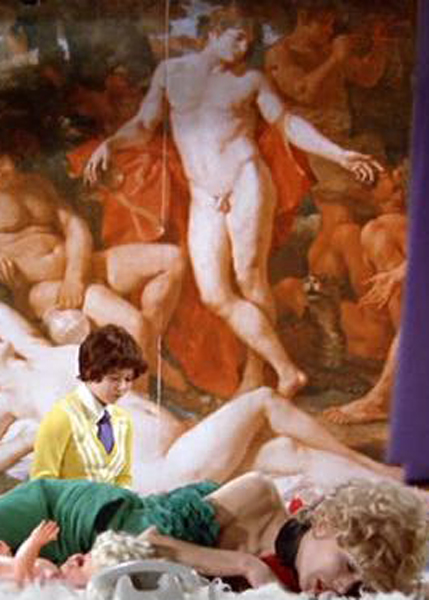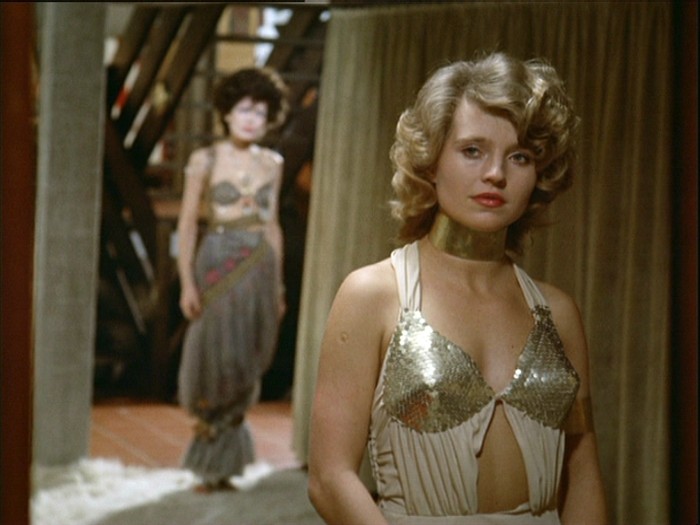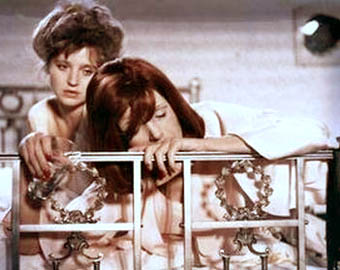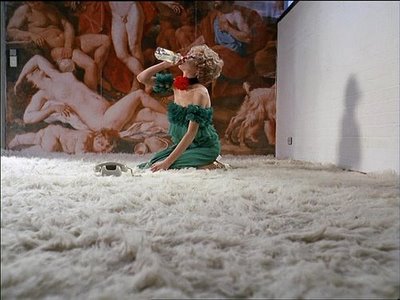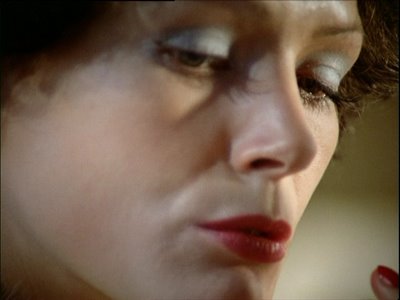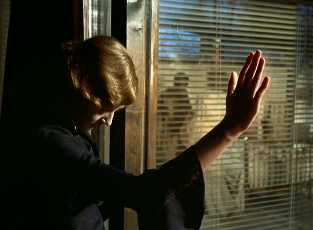This essay was commissioned by the Australian DVD label Madman, for their 2008 release of The Bitter Tears of Petra von Kant. In fact, I wrote essays about four separate Fassbinder films for them — the three others were Katzelmacher, Ali: Fear Eats the Soul, and Martha. —J.R.

“I love movies. Pictures about passion—and pain. Lovely!
[…] “Discipline’s okay as long as you’re having fun.”
–Karin (Hanna Schygulla) in The Bitter Tears of Petra Von Kant
An early watershed in Rainer Werner Fassbinder’s career as a filmmaker, The Bitter Tears of Petra von Kant (1972), his twelfth feature, might even be regarded as the first in which he explicitly “discovered” mise en scène. Adapting his own play —- which had premiered in Darmstadt half a year before, in June 1971, in a production directed by Peer Raben —- the film makes no effort to “open up” the original material in terms of its original setting, the flat of its title heroine, and it focuses on issues of camera placement and camera movement like few other Fassbinder films made before or since.
For Christian Braad Thomsen, who may be Fassbinder’s most authoritative critic, the film marks a significant turning point. After completing work on Pioneers in Ingolstadt, Fassbinder took an eight-month break, which in terms of his usual breakneck speed and productivity was unprecedented. It was during this period that he first saw and wrote about half a dozen Douglas Sirk films, during the winter of 1970-71 —- which inspired a major reorientation of his filmmaking practice, as well as a personal visit with his film crew to Sirk at his home in Lugano, Switzerland, where he had retired after terminating his Hollywood career with Imitation of Life in 1959. According to Thomsen, the first two Fassbinder films made after this meeting, The Merchant of Four Seasons (1971) and The Bitter Tears of Petra von Kant (1972), both show the mark of Sirk’s influence, albeit in separate ways, and both had autobiographical origins: the first was inspired by an incident in Fassbinder’s family and the second was essentially a recasting of Fassbinder’s own relationships with his lover Günther Kaufmann (a black Bavarian whose father was an American GI during the postwar German occupation) and his assistant (or devoted “slave”) Peer Raben. (Fassbinder’s first explicit and detailed depiction of male homosexuality would come in his 1974 feature Fox and His Friends, and The Bitter Tears, with its lesbian characters, might be regarded as a significant way station, paving the way towards this candor.)
Each of these features inaugurates a new strain in Fassbinder’s work which Thomsen labels, respectively, “bourgeois” films and “cinema” films. And the joint significance of these two new strains is that they mark the overall shift of Fassbinder during this period from being a marginal and somewhat experimental artist to achieving the status of more widely recognized and celebrated arthouse director. This shift was accompanied, moreover, by a certain political change, at least in some of the implications of his work.
Subtitled “a case history” and dedicated “to the one who became Marlene here” (which would appear to be Peer Raben), The Bitter Tears focuses during its credits on a couple of cats nibbling on food on the four steps between the two floors of the title heroine’s apartment. As the credits end, we see Marlene (Irm Hermann) moving behind the steps as the camera pulls back and then tracks to the right, passing first a frameless painting which covers the entire back wall of Petra’s bedroom — a cropped reproduction of Nicolas Poussin’s Midas and Dionysos (1629)–and then, in the foreground, the full length of Petra’s bed, moving from foot to head, where Petra lies sleeping, until Marlene, offscreen, opens the blinds.
What follows is a discontinuous monologue by Petra as she slowly and very gradually maneuvers her way out of bed, interrupted mainly by the successive orders she gives to her secretary-assistant Marlene, all of which Marlene silently and dutifully fulfills or accepts: to bring Petra the phone (so that she can call her mother); to squeeze her a glass of orange juice; to “start on the drawing” (Petra is a fashion designer, and part of Marlene’s work is to execute her designs on paper); to type a letter that she dictates to one “Joseph Mankiewicz,” saying that she’ll be unable to make a scheduled payment on a loan (apparently because of a 5,000-mark loan she has just agreed to give to her mother); to bring her the typed letter so she can sign it; to post the letter (“and be quick”); to dance with her to the record (by this time, Petra has finally gotten out of bed and put on, successively, a robe, a record by the Platters [“Smoke Gets in Your Eyes”], and a wig); to resume her drawing (which “must be done by noon”), and then to interrupt this work in turn to fetch her the mail.
The beginning of this opening sequence is deceptive but pointed —- deceptive because the presence of the two cats suggests some elements of chance in the mise en scène (especially if we overlook the prior placement of food on the stairs to ensure their presence there), and pointed because we’re introduced to the Poussin painting before we’re introduced to Petra von Kant herself, and because the arbitrariness of Petra’s despotic rule over Marlene is already being highlighted.
As for “Joseph Mankiewicz,” this is most likely a nod to All About Eve, which also centers on the ambiguous relationship between a temperamental diva and a dutiful, worshipful protégé. And Sirk, though he isn’t cited verbally, is certainly a reference point in the flamboyant employments of color and lighting, not to mention the overall ambience of melodrama and “women’s pictures”. Furthermore, in a more general fashion, Fassbinder might be said to be taking some of his cues from the everyday perversity of certain Hollywood melodramas, noirs in particular, such as Gilda —- that is, pointing up the perversity that can already be found in such pictures and then replicating some of their features in a campier and more self-aware style.
What’s perverse here is not only the mistress-slave relationship between Petra and Marlene, but also the affair that is launched before the end of the first act between Petra and Karin (Hanna Schygulla), at least as it develops in subsequent acts, and the ambiguous shifts in power and control between them. But it’s important to add that the perversity of this relationship, as perceived by Fassbinder, isn’t automatically mandated by the fact that it’s homosexual. On the contrary, the possibility of progressive liberation from the perversions of patriarchy is raised by this film before it’s decisively squelched.
There’s a brilliant essay by Lynne Kirby called “Fassbinder’s Debt to Poussin” that appeared in Camera Obscura no. 13-14 (Spring-Summer 1985) and analyzes the complex functions of the painting in relation the film’s mise en scène and meaning. Without attempting to summarize Kirby’s lengthy and multifaceted argument, it seems worth quoting the first part of her description of the painting as a way of underlining its most salient feature, the positioning of male figures—-which is all the more striking because no other onscreen male figures appear in the film:
Defined overwhelmingly by its predominant
foreground, the space of the represented
painting divides into two major domains, each
anchored in a figure constituted as the opposite
of the other. The left-hand side features an
ecstatic bacchante stretched out between the
dozing infant lying below her, and the drunken
Silenus slumped over his wine jug perched above.
The figure of Midas bowed before that of Dionysos
fills the right side, although a few other male
figures and the rear-end of a goat are squeezed in
as well. The mural is evidently cut to fit the
wall, since the original painting extends further
to the right and top. Reframed for symmetry, the
female and Midas are meant to be seen as opposites,
as sexually different, as symbolically other; this
is indicated not only by their different skin
colors (traditional in mythological painting: white
for women, bronze for men), or the different states
of consciousness indexed by their respective posi-
tions. The spatial division itself is constructed
around the figure at the center of the painting,
Dionysos. With his arms spread out on both sides of
his body, the corporeal disposition of this figure
seems to say, “on the one hand, men; on the other,
women—-” and in between, himself. (1)
The crucial significance being pinpointed here is the simultaneous determination, claim, failure, and inability of Petra von Kant (and, by extension, Fassbinder himself) to live and act freely, outside the bourgeois norms of patriarchy. In Petra’s terms, this means her failure to achieve in her relationship to Karin something more liberated than a replication or parody of heterosexual behavior in terms of possessiveness. The Poussin painting, in short, serves as a mocking rebuke to Petra’s pretense to have transcended the limitations of her two previous and failed heterosexual marriages —- which is also why virtually the entire action of the film is framed between the two sides of a 45 RPM record of The Platters that she plays on her phonograph, “Smoke Gets in Your Eyes” at the beginning and “The Great Pretender” at the end. It’s almost as if Fassbinder was bracketing his own plot as a failed self-psychoanalysis, yielding a cynical autocritique that inherently posits any change as impossible. It might be oversimplifying matters to claim that this flip position made his work both more commercial and less political. But it would be less of a stretch to say that it made his attitude more humorous and fashionable. (Spoiler alert: those who haven’t yet seen the film are cautioned to stop reading here.)
The sarcastic end of the film, however, is not the same ending found in the play, which was more open- ended. At the play’s end, Petra says to Marlene, after having just liberated her, “Now tell me about your life”—-echoing the invitation she made earlier to Karin–at which point the final curtain falls. In the film, the same declaration is followed first by Petra putting on the record “The Great Pretender,” which then plays over the remaining action, and then by Marlene immediately packing her suitcase in the foreground of the shot before she leaves the premises.
In his book-length study of Fassbinder (2), Thomsen persuasively criticizes this ending of the film on two counts: (a) One of the items packed in her suitcase by Marlene is a revolver, which makes its first and only appearance at this moment—-and which Thomsen faults, even though it can be taken as a personal reference to the revolvers that crop up in many of Fassbinder’s earlier films, because it functions primarily and not secondarily as a symbol. (In a 1973 interview with Thomsen, Fassbinder suggested that it was used in order to stress that Marlene’s slavery was voluntary, but this fact was surely already clear without it.) (b) The song “The Great Pretender” implies in a rather facile way that Petra’s claims at liberating herself from patriarchy were fraudulent from the beginning.
One other detail in this ending seems worthy of mention, if only because it implies the same defeatist resolution, with just as many inherent contradictions. Just before Petra says to Marlene, “Tell me about yourself,” she says, “I have to apologize to you for many things, Marlene. In [the] future, we’ll really work together. You’ll have what you’re entitled to —- freedom and fun!” Marlene then steps forward and rather meekly kisses Petra’s hand, and Petra sharply responds by saying, “Not like that!”
Even though the intellectual and emotional battle waged throughout The Bitter Tears is ultimately lost, it remains alive as long as the mise en scène might be said to persist as a mode of inquiry. One of the most telling signs of life in this inquiry appears to be Fassbinder’s desire to keep his camera in motion, within or between shots (to mark changes of camera angles), whenever it can still function as a means of discovery or rediscovery, a way of redefining or potentially breaking free of compulsive behavior and oppressive power relations. It hardly seems coincidental that the plot’s overall development towards defeatism can also be traced to some degree in the growing proliferation of long, static takes filmed from fixed angles, when neither the camera nor the actors seem able to budge. (Another growing tendency —- the habit of characters speaking to one another while looking in opposite directions —- reflects the possible influence of Carl Dreyer’s Gertrud, with its own tragic stalemates between freedom and some form of predestination. But properly speaking, the rather reductive and vulgarized fusion of Dreyer and Fassbinder wouldn’t come about until some time later, with the arrival of Lars von Trier.)
The broad issue of how and to what degree freedom can be said to exist within a sadomasochistic relationship is an ongoing preoccupation of Fassbinder’s work, and here it can be said to surface periodically in the costumes (e.g., the “slave” dresses worn by both Petra and Karin), in the placements of both the actors and the camera (which sometimes juxtapose characters in relation to their relative degrees of power and/or mobility, and sometimes juxtapose them with mannequins and/or diverse figures in the Poussin painting), and in the degrees of mobility or stasis assigned at various junctures to the camera. That it ends with a fixed angle framing the departure of Marlene–an act positioned as a kind of bitter punch line–suggests that at some point between the premiere of the play and the ten-day shoot of this film, half a year later, Fassbinder lost faith in his own capacity for change.
Footnotes
1. Kirby, Lynne, op. cit., p. 5.
2. Thomsen, Christian Braad, Fassbinder: The Life and Work of a Provocative Genius, translated by Martin Chalmers, Minneapolis: University of Minnesota Press, 2004, p. 116.

